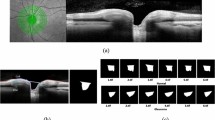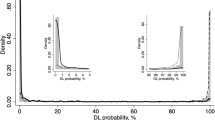Abstract
Background/Aims
To objectively classify eyes as either healthy or glaucoma based exclusively on data provided by peripapillary retinal nerve fiber layer (pRNFL) and ganglion cell-inner plexiform (GCIPL) measurements derived from spectral-domain optical coherence tomography (SD-OCT) using machine learning algorithms.
Methods
Three clustering methods (k-means, hierarchical cluster analysis -HCA- and model-based clustering-MBC-) were used separately to classify a training sample of 109 eyes as either healthy or glaucomatous using solely 13 SD-OCT parameters: pRNFL average and sector thicknesses and GCIPL average and minimum values together with the six macular wedge-shaped regions. Then, the best-performing algorithm was applied to an independent test sample of 102 eyes to derive close estimates of its actual performance (external validation).
Results
In the training sample, accuracy was 91.7% for MBC, 81.7% for k-means and 78.9% for HCA (p value = 0.02). The best MBC model was that in which subgroups were allowed to have variable volume and shape and equal orientation. The MBC algorithm in the independent test sample correctly classified 98 out of 102 cases for an overall accuracy of 96.1% (95% CI, 92.3–99.8%), with a sensitivity of 94.3 and 100% specificity. The accuracy for pRNFL was 92.2% (95% CI, 86.9–97.4%) and for GCIPL 98.0% (95% CI, 95.3–100%).
Conclusions
Clustering algorithms in general (and MBC in particular) seem promising methods to help discriminate between healthy and glaucomatous eyes using exclusively SD-OCT-derived parameters. Understanding the relative merits of one method over others may also provide insights into the nature of the disease.
This is a preview of subscription content, access via your institution
Access options
Subscribe to this journal
Receive 18 print issues and online access
$259.00 per year
only $14.39 per issue
Buy this article
- Purchase on Springer Link
- Instant access to full article PDF
Prices may be subject to local taxes which are calculated during checkout

Similar content being viewed by others
Data availability
All data generated or analyzed during this study are included in this published article (and its Supplementary Information files).
References
Tham YC, Li X, Wong TY, Quigley HA, Aung T, Cheng CY. Global prevalence of glaucoma and projections of glaucoma burden through 2040: a systematic review and meta-analysis. Ophthalmology. 2014;121:2081–90.
Greenfield DS, Weinreb RN. Role of optic nerve imaging in glaucoma clinical practice and clinical trials. Am J Ophthalmol. 2008;145:598–603.
Varma R, Steinmann WC, Scott IU. Expert agreement in evaluating the optic disc for glaucoma. Ophthalmology. 1992;99:215–21.
Jampel HD, Friedman D, Quigley H, Vitale S, Miller R, Knezevich F, et al. Agreement among glaucoma specialists in assessing progressive disc changes from photographs in open-angle glaucoma patients. Am J Ophthalmol. 2009;147:39–44.e1.
Susanna R, De Moraes CG, Cioffi GA, Ritch R. Why do people (still) go blind from glaucoma? Transl Vis Sci Technol. 2015;4:1.
Chen TC, Hoguet A, Junk AK, Nouri-Mahdavi K, Radhakrishnan S, Takusagawa HL, et al. Spectral-domain OCT: helping the clinician diagnose glaucoma. Ophthalmology. 2018;125:1817–27.
Blumberg DM, De Moraes CG, Liebmann JM, Garg R, Chen C, Theventhiran A, et al. Technology and the glaucoma suspect. Invest Ophthalmol Vis Sci. 2016;57:OCT80–5.
Ramachandran R, Joiner DB, Patel V, Popplewell D, Misra P, Kaplan CM, et al. Comparison between the recommendations of glaucoma specialists and OCT report specialists for further ophthalmic evaluation in a community-based screening study. Ophthalmol Glaucoma. 2022;5:602–13.
Mwanza JC, Warren JL, Budenz DL. Utility of combining spectral domain optical coherence tomography structural parameters for the diagnosis of early Glaucoma: a mini-review. Eye Vis. 2018;5:9.
Giordani P, Ferraro MB, Martella F. An introduction to clustering with R. Vol 1. 1st ed. Singapore: Springer; 2020. p. 20.
Fraley C, Raftery AE. Model-based clustering, discriminant analysis, and density estimation. J Am Stat Assoc. 2002;97:611–31.
Anderson DR, Patella VM. Automated static perimetry. 2nd ed. St. Louis: Mosby; 1999.
Hubert L, Arabie P. Comparing partitions. J Classif. 1985;2:193–218.
Biarnés M, Ferraro LL, Garcia M, Delcourt C, Lengyel I, Monés J. Re: Keenan et al.: Cluster analysis and genotype-phenotype assessment of geographic atrophy in age-related macular degeneration: AREDS2 Report 25 (Ophthalmology. 2021;5(11):1061-1073). Ophthalmol Retin. 2022;6:333–4.
Bae HW, Ji Y, Lee HS, Lee N, Hong S, Seong GJ, et al. A hierarchical cluster analysis of normal-tension glaucoma using spectral-domain optical coherence tomography parameters. J Glaucoma. 2015;24:328–33.
Birla S, Gupta D, Somarajan BI, Gupta S, Chaurasia AK, Kishan A, et al. Classifying juvenile onset primary open angle glaucoma using cluster analysis. Br J Ophthalmol. 2020;104:827–35.
Howell GR, Macalinao DG, Sousa GL, Walden M, Soto I, Kneeland SC, et al. Molecular clustering identifies complement and endothelin induction as early events in a mouse model of glaucoma. J Clin Invest. 2011;121:1429–44.
Yan S, Abidi SSR, Artes PH. Analyzing sub-classifications of glaucoma via SOM based clustering of optic nerve images. Stud Health Technol Inf. 2005;116:483–8.
Schulze A, Lamparter J, Pfeiffer N, Berisha F, Schmidtmann I, Hoffmann EM. Diagnostic ability of retinal ganglion cell complex, retinal nerve fiber layer, and optic nerve head measurements by Fourier-domain optical coherence tomography. Graefes Arch Clin Exp Ophthalmol. 2011;249:1039–45.
Pazos M, Dyrda AA, Biarnés M, Gómez A, Martín C, Mora C, et al. Diagnostic accuracy of spectralis SD OCT automated macular layers segmentation to discriminate normal from early glaucomatous eyes. Ophthalmology. 2017;124:1218–28.
Mwanza JC, Durbin MK, Budenz DL, Sayyad FE, Chang RT, Neelakantan A, et al. Glaucoma diagnostic accuracy of ganglion cell-inner plexiform layer thickness: comparison with nerve fiber layer and optic nerve head. Ophthalmology. 2012;119:1151–8.
Mwanza JC, Durbin MK, Budenz DL. Interocular symmetry in peripapillary retinal nerve fiber layer thickness measured with the cirrus HD-OCT in healthy eyes. Am J Ophthalmol. 2011;151:514–21.e1.
Scrucca L, Fop M, Murphy BT, Raftery AE. Mclust. R J. 2016;8:289–317.
Medeiros FA, Tatham AJ. Structure versus function in glaucoma: the debate that doesn’t need to be. Ophthalmology. 2016;123:1170–2.
Kuang TM, Zhang C, Zangwill LM, Weinreb RN, Medeiros FA. Estimating lead time gained by optical coherence tomography in detecting glaucoma before development of visual field defects. Ophthalmology. 2015;122:2002–9.
Medeiros FA, Zangwill LM, Bowd C, Mansouri K, Weinreb RN. The structure and function relationship in glaucoma: implications for detection of progression and measurement of rates of change. Invest Opthalmol Vis Sci. 2012;53:6939–46.
Quigley HA, Addicks EM. Chronic experimental glaucoma in primates. II. Effect of extended intraocular pressure elevation on optic nerve head and axonal transport. Invest Ophthalmol Vis Sci. 1980;19:137–52.
Martin KRG, Quigley HA, Valenta D, Kielczewski J, Pease ME. Optic nerve dynein motor protein distribution changes with intraocular pressure elevation in a rat model of glaucoma. Exp Eye Res. 2006;83:255–62.
Hood DC. Improving our understanding, and detection, of glaucomatous damage: an approach based upon optical coherence tomography (OCT). Prog Retin Eye Res. 2017;57:46–75.
Pazos M, Biarnés M, Blasco-Alberto A, Dyrda A, Luque-Fernández MÁ, Gómez A, et al. SD-OCT peripapillary nerve fibre layer and ganglion cell complex parameters in glaucoma: principal component analysis. Br J Ophthalmol. 2021;105:496–501.
Hood DC, Raza AS, de Moraes CG, Liebmann JM, Ritch R. Glaucomatous damage of the macula. Prog Retin Eye Res. 2013;32:1–21.
Hood DC, la Bruna S, Tsamis E, Thakoor KA, Rai A, Leshno A, et al. Detecting glaucoma with only OCT: implications for the clinic, research, screening, and AI development. Prog Retin Eye Res. 2022;90:101052.
Patel NB, Wheat JL, Rodriguez A, Tran V, Harwerth RS. Agreement between retinal nerve fiber layer measures from spectralis and cirrus spectral domain OCT. Optom Vis Sci. 2012;89:E652–66.
Lim CY, In J. Randomization in clinical studies. Korean J Anesthesiol. 2019;72:221–32.
Schulz KF, Grimes DA. Unequal group sizes in randomised trials: guarding against guessing. Lancet. 2002;359:966–70.
Author information
Authors and Affiliations
Contributions
MB contributed to design of the study, data analysis, interpretation, and writing. NVA was responsible for data acquisition and collection, data analysis, interpretation, and writing. RCD, FF, SBF, MTCD, and IRU collected data. MJM and EM data interpretation, review. MP contributed to conception and design, data acquisition, interpretation, writing and preparation of the manuscript.
Corresponding author
Ethics declarations
Competing interests
MB, FF, SBF, MTCD, RCD, EM, MJM: none. NVA and IRU: Lecturer for Carl Zeiss Meditec. MP: Lecturer and Consultant Carl Zeiss Meditec, Editorial board member for Eye.
Additional information
Publisher’s note Springer Nature remains neutral with regard to jurisdictional claims in published maps and institutional affiliations.
Supplementary information
Rights and permissions
Springer Nature or its licensor (e.g. a society or other partner) holds exclusive rights to this article under a publishing agreement with the author(s) or other rightsholder(s); author self-archiving of the accepted manuscript version of this article is solely governed by the terms of such publishing agreement and applicable law.
About this article
Cite this article
Biarnés, M., Ventura-Abreu, N., Rodríguez-Una, I. et al. Classifying glaucoma exclusively with OCT: comparison of three clustering algorithms derived from machine learning. Eye 38, 841–846 (2024). https://doi.org/10.1038/s41433-023-02785-5
Received:
Revised:
Accepted:
Published:
Issue Date:
DOI: https://doi.org/10.1038/s41433-023-02785-5



